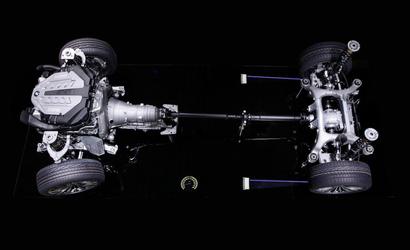
Integral Active Steering
With the Integral Active Steering from BMW, the rear wheels help to steer and provide more driving stability, safety and comfort.
Different driving situations call for different steering responses. A smaller turning circle with fewer movements and more precise movements is helpful when parking or negotiating hairpin bends.
The optional Integral Active Steering adapts to each driving situation. An electric motor in the steering column changes the driver’s steering movements dynamically – the amount of effort needed to turn the front wheels is automatically increased at low speeds and reduced at high speeds.
The rear wheels help to turn up to a maximum of three degrees – a small movement with a large effect. The precise angle of lock is determined by a control device after measuring factors like wheel speed, speed, steering wheel angle, etc. Under 60 km/h, the front and rear wheels steer in opposing directions to reduce the turning circle and ensure every bend is taken with precision. Above 60 km/h the front and rear wheels turn in the same direction to ensure more stability at higher speeds. When changing lanes, the vehicle practically ‘glides’ in an even sideways motion, which extremely comfortable for all the vehicle’s occupants and especially so for those in the rear.
From a physical point of view, the Integral Active Steering lets the forces from rotational movement (rate of yaw) and lateral acceleration – forces which normally work together – work systematically and, above all, independently of each other. Thus, stability remains constant even in sporty driving situations. The extra safety is noticeable when braking on different surfaces, where the vehicle may tend to swerve, as the usual counter steering measures are not applicable here. Integral Active Steering takes on this function and helps the driver stabilise his vehicle.
Back to list
Different driving situations call for different steering responses. A smaller turning circle with fewer movements and more precise movements is helpful when parking or negotiating hairpin bends.
The optional Integral Active Steering adapts to each driving situation. An electric motor in the steering column changes the driver’s steering movements dynamically – the amount of effort needed to turn the front wheels is automatically increased at low speeds and reduced at high speeds.
The rear wheels help to turn up to a maximum of three degrees – a small movement with a large effect. The precise angle of lock is determined by a control device after measuring factors like wheel speed, speed, steering wheel angle, etc. Under 60 km/h, the front and rear wheels steer in opposing directions to reduce the turning circle and ensure every bend is taken with precision. Above 60 km/h the front and rear wheels turn in the same direction to ensure more stability at higher speeds. When changing lanes, the vehicle practically ‘glides’ in an even sideways motion, which extremely comfortable for all the vehicle’s occupants and especially so for those in the rear.
From a physical point of view, the Integral Active Steering lets the forces from rotational movement (rate of yaw) and lateral acceleration – forces which normally work together – work systematically and, above all, independently of each other. Thus, stability remains constant even in sporty driving situations. The extra safety is noticeable when braking on different surfaces, where the vehicle may tend to swerve, as the usual counter steering measures are not applicable here. Integral Active Steering takes on this function and helps the driver stabilise his vehicle.









